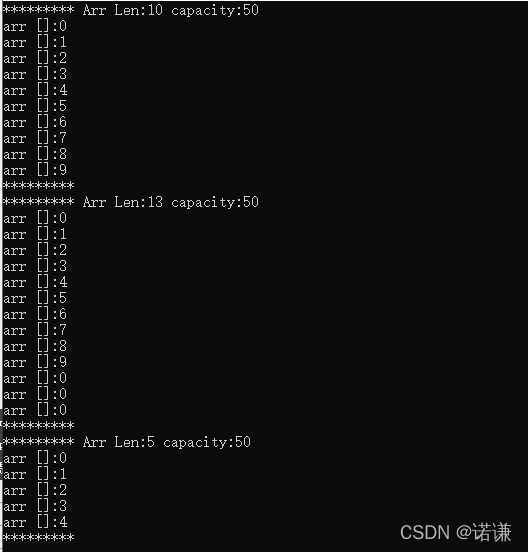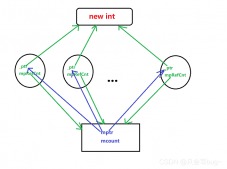1.实现机制
内部主要通过m_capacity数组容量成员和m_length数组有效长度成员来维护一个T* data数组空间.
内部默认分配一定数量大小的数组指针,每次append尾部追加的时候,无需再次分配空间,直接赋值标志length长度,假如超过当前空间容量,则再次扩大分配新的内存数组,并将旧数组拷贝至新数组及释放旧数组.
Vector需要实现的public函数如下所示:
-
inline int capacity(): 获取容量 -
inline int length() :获取有效长度 -
void resize(int asize) :改变数组的有效长度 -
void append(const T &t) :尾部追加一个元素 -
T& operator[] (int i) :通过[]获取元素 -
T operator[] (int i) const :通过[]获取常量元素 -
void clear() :清空数组中的数据 -
inline bool isEmpty():数组是否有数据
resize()函数实现细节:
- 如果resize长度大于当前容量时 : 则扩大分配新的内存数组,并将旧数组拷贝至新数组及释放旧数组.
- 如果resize长度小于当前length时 : 则需要将多余的成员进行释放,调用析构函数实现.
- 如果resize长度大于当前length时 : 则需要调用默认构造函数来填充内部数组.
2.代码实现
|
1
2
3
4
5
6
7
8
9
10
11
12
13
14
15
16
17
18
19
20
21
22
23
24
25
26
27
28
29
30
31
32
33
34
35
36
37
38
39
40
41
42
43
44
45
46
47
48
49
50
51
52
53
54
55
56
57
58
59
60
61
62
63
64
65
66
67
68
69
70
71
72
73
74
75
76
77
78
79
80
81
82
83
84
85
86
87
88
89
90
91
92
93
94
95
96
97
98
99
100
|
#ifndef VECTOR_H#define VECTOR_H#include "throw.h"// throw.h里面定义了一个ThrowException抛异常的宏,如下所示://#include <iostream>//using namespace std;//#define ThrowException(errMsg) {cout<<__FILE__<<" LINE"<<__LINE__<<": "<<errMsg<<endl; (throw errMsg);}template <typename T>class Vector{ T* m_data; int m_length; // 有效数据的长度 int m_capacity; // 分配容量的长度 // 分配 T* allocate(int size) { T* arr = new T[size]; if(arr == NULL) { ThrowException( "No memory to create DynamicArray object ..."); } return arr; } // 重新分配 void realloc(int capacity) { T* newData = allocate(capacity); for(int i=0; i<m_length; i++) { newData[i] = m_data[i]; } delete[] m_data; m_data = newData; m_capacity = capacity; } // 调用析构函数 void destruct(int from, int end) { while(from++<end) { m_data[from].~T(); } } // 调用默认构造函数 void defaultConstruct(int from, int end) { while(from++<end) { m_data[from] = T(); } }public: Vector(int lenght = 50) { m_length = 0; m_data = allocate(lenght); m_capacity = lenght; } inline int capacity() const { return m_capacity; } // 获取容量 inline int size() { return m_length; } // 获取有效长度 inline int length() { return size(); } inline T *data() { return m_data; } inline const T *data() const { return m_data; } inline bool isEmpty() const { return m_length == 0; } void clear() { if(!m_length) return; destruct(0, m_length); m_length = 0; } void resize(int asize) { if(asize == m_length) return; // 重新分配的大小>当前容量时 if(asize > m_capacity) { realloc(asize); } if (asize < m_length) // 分配的大小<当前大小时,则调用析构 destruct(asize, m_length); else // 分配的大小>当前大小时,则调用默认构造 defaultConstruct(m_length, asize); m_length = asize; } // 尾部追加一个元素 void append(const T &t) { if(m_length == m_capacity) { realloc(m_capacity+20); // 如果容量满了,则默认增加20个容量.方便后面append无需再次分配内存 } m_data[m_length] = t; m_length++; } T& operator[] (int i) { if((0 <= i) && (i < length())) { return m_data[i]; } else { ThrowException("Parameter i is invalid ..."); } } T operator[] (int i) const { return m_data[i]; }};#endif // VECTOR_H |
3.测试运行
测试如下所示:
|
1
2
3
4
5
6
7
8
9
10
11
12
13
14
15
16
17
18
19
20
21
22
23
24
25
26
27
28
|
class Test {public: int number; Test(int n = 0) { number = n; }};int main(int argc, char *argv[]){ Vector<Test> arr; for(int i = 0; i < 10; i++) arr.append(Test(i)); cout<<"********* Arr Len:"<<arr.length()<<" capacity:"<<arr.capacity()<<endl; for(int i = 0; i < arr.length(); i++) cout<<"arr []:"<<arr[i].number<<endl; cout<<"*********"<<endl; arr.resize(13); cout<<"********* Arr Len:"<<arr.length()<<" capacity:"<<arr.capacity()<<endl; for(int i = 0; i < arr.length(); i++) cout<<"arr []:"<<arr[i].number<<endl; cout<<"*********"<<endl; arr.resize(5); cout<<"********* Arr Len:"<<arr.length()<<" capacity:"<<arr.capacity()<<endl; for(int i = 0; i < arr.length(); i++) cout<<"arr []:"<<arr[i].number<<endl; cout<<"*********"<<endl; return 0;} |
运行如下所示:

可以看到我们resize(13)后,由于 resize长度大于当前arr的length,所以则调用默认构造函数来填充内部数组.所以arr[10]至arr[12]的number为0。
总结
本篇文章就到这里了,希望能够给你带来帮助,也希望您能够多多关注服务器之家的更多内容!
原文链接:https://blog.csdn.net/qq_37997682/article/details/123111695













